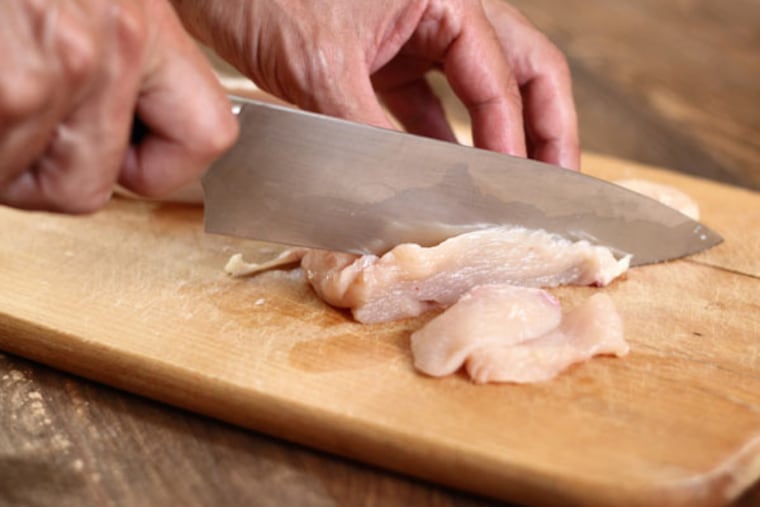How to avoid food poisoning at home
When preparing food at home, do you: Clean sponges with soap to kill bacteria after wiping up drippings on countertops?

When preparing food at home, do you:
Clean sponges with soap to kill bacteria after wiping up drippings on countertops?
Cover Tupperware containers when cooling hot food in the fridge?
Rinse chicken in the sink?
All not good.
"Washing a sponge with soap doesn't get rid of bacteria," said microbiologist Michael Doyle, director of the University of Georgia's Center for Food Safety. They grow at room temperature and get spread around anything else you wipe off.
"Put the sponge in a microwave for one minute to kill the salmonella and other bacteria," he said.
Overall, keeping your family safe from home-grown food-borne illness is not that different from what restaurants must do. Though restaurants serve more people and may get blamed - fairly or unfairly - for illness, experts say most home kitchens are far dirtier.
That's not surprising, because restaurateurs must pass surprise inspections based on hundreds of pages of regulations, including a requirement to have an employee trained and certified in food safety on the premises at all times.
Cross-contamination may be the biggest cause of food-borne illness at home. That's why raw meat should never be placed on a refrigerator shelf above salads; it could drip.
After washing your hands, dry them with a paper towel or a cloth that is not used for anything else. Cutting boards should not have hard-to-clean nicks and grooves (wood is better, Doyle said, because the resin has antibacterial properties).
Washing chicken in the sink may sound hygienic but actually poses all sorts of risks. It can splash on counters, dry dishes, your arms. The sink and anything in it is obviously contaminated. So is the drain.
"You would think that because the drain is a downward flow of water that shouldn't be an issue," said Craig Hedberg, a professor at the University of Minnesota School of Public Health. "But lots of things can happen. Every time you run your disposal in the sink you are generating a little airflow back up."
If you do wash chicken in the sink, clean it (the sink) with bleach (1 ounce in 1 gallon of water).
Temperature is another big risk area in home kitchens. Use a food thermometer to ensure sufficient cooking, each for 15 seconds: fish, meat, and raw eggs to be eaten immediately (145 degrees); ground meat and fish (155 degrees); and poultry, wild game, and raw eggs to be held (165 degrees).
Cooling them properly for later use is often overlooked.
"If you take this big mass of hot food and put it into a plastic container and put a lid on it, you are holding the heat in and slowing the cooling process, even if you put it in the refrigerator," Hedberg said. "You want to get it out of bacterial-growth range" - 40 to 140 degrees - "within a couple of hours." Pouring it into containers no more than four inches deep speeds the process.
If food is not cooled fast enough, spores that survived cooking can germinate and grow bacteria. Reheating leftovers to 165 degrees for 15 seconds will kill them.
Food-safety experts can tick off many unpleasant surprises. Listeria can grow in soft cheeses even when properly refrigerated; they should be tossed after a week.
And Hedberg advises against washing prewashed bagged lettuce; E. coli and salmonella can adhere to cut surfaces and tiny pores.
"If it's contaminated, your washing it again would not eliminate the contamination," he said. "If it is not contaminated, your washing may contaminate it."
Some more key points:
Hands should be washed vigorously with soap before preparing food or eating; after handling raw meat, poultry, fish, or even raw produce; and after smoking, eating, or drinking.
Countertops, cutting boards, utensils, etc., should be cleaned with hot water after every use.
Cooking and holding temperatures should be checked, which means having working thermometers. (The fridge should be set between 32 and 40 degrees Fahrenheit; the freezer, at zero or below).
Everything should be clean: Garbage covered, or at least three feet from food-preparation areas; pets never allowed in the kitchen (and hands washed after petting).
To bring home cooks up to speed, the Rutgers University Cooperative Extension posts a quick home kitchen food safety best practices check-Up list: http://bit.ly/1xDO19F.
For those who take their food safety more seriously, the Los Angeles County Department of Public Health posts a more detailed home kitchen self inspection. Borrowing an idea from the county's restaurant inspection program, it gives a letter grade (I got a C). Go to: http://1.usa.gov/15fPjzz.
215-854-2617 @DonSapatkin